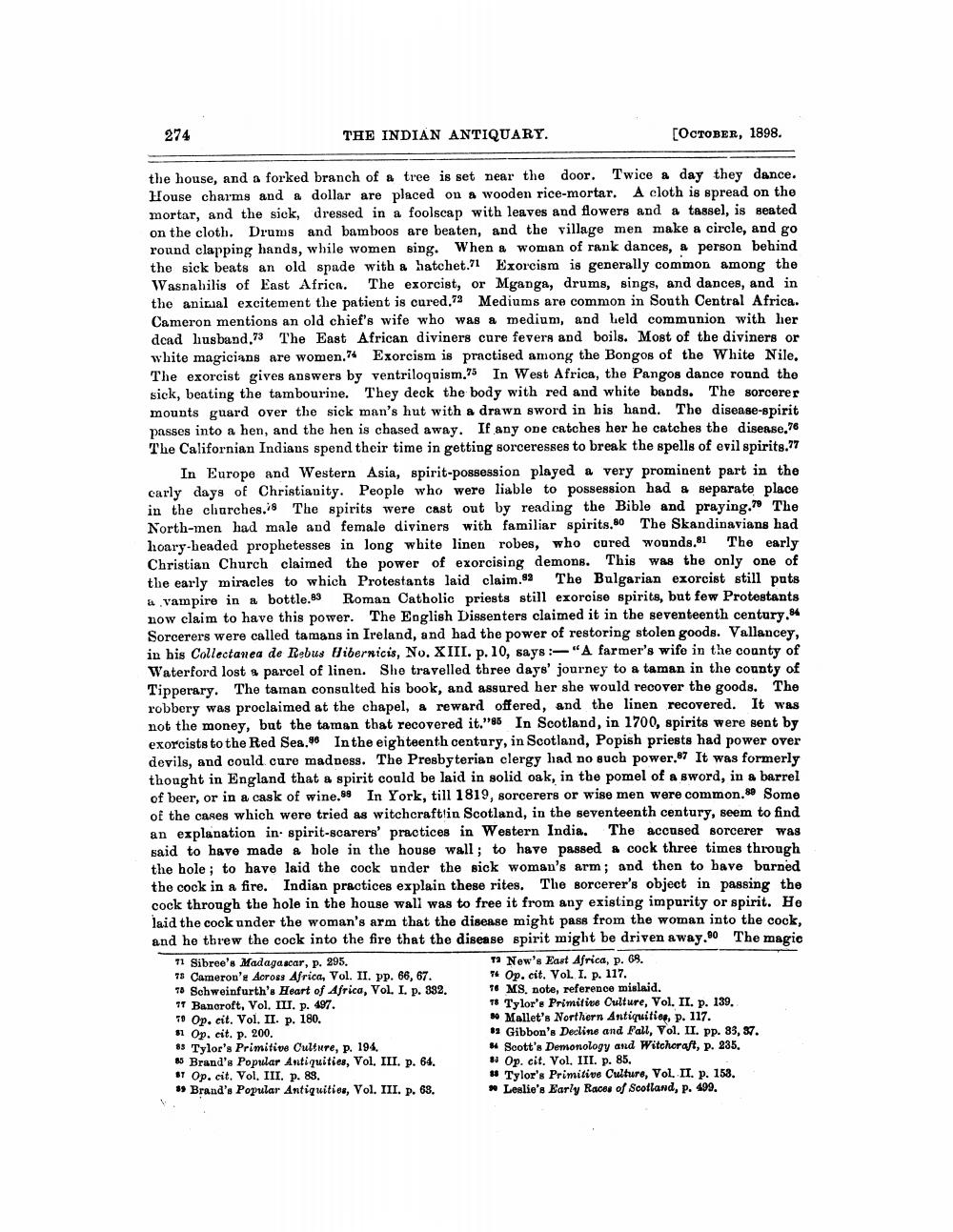________________
274
THE INDIAN ANTIQUARY.
the house, and a forked branch of a tree is set near the door. Twice a day they dance. House charms and a dollar are placed on a wooden rice-mortar. A cloth is spread on the mortar, and the sick, dressed in a foolscap with leaves and flowers and a tassel, is seated on the cloth. Drums and bamboos are beaten, and the village men make a circle, and go round clapping hands, while women sing. When a woman of rank dances, a person behind the sick beats an old spade with a hatchet.71 Exorcism is generally common among the Wasnahilis of East Africa. The exorcist, or Mganga, drums, sings, and dances, and in the animal excitement the patient is cured.72 Mediums are common in South Central Africa. Cameron mentions an old chief's wife who was a medium, and held communion with her dead husband.73 The East African diviners cure fevers and boils. Most of the diviners or white magicians are women. Exorcism is practised among the Bongos of the White Nile. The exorcist gives answers by ventriloquism.75 In West Africa, the Pangos dance round the sick, beating the tambourine. They deck the body with red and white bands. The sorcerer mounts guard over the sick man's hut with a drawn sword in his hand. The disease-spirit passes into a hen, and the hen is chased away. If any one catches her he catches the disease,76 The Californian Indians spend their time in getting sorceresses to break the spells of evil spirits."7
[OCTOBER, 1898.
In Europe and Western Asia, spirit-possession played a very prominent part in the carly days of Christianity. People who were liable to possession had a separate place in the churches.is The spirits were cast out by reading the Bible and praying.70 The North-men had male and female diviners with familiar spirits.80 The Skandinavians had hoary-headed prophetesses in long white linen robes, who cured wounds.81 The early Christian Church claimed the power of exorcising demons. This was the only one of the early miracles to which Protestants laid claim.82 The Bulgarian exorcist still puts a vampire in a bottle.83 Roman Catholic priests still exorcise spirits, but few Protestants now claim to have this power. The English Dissenters claimed it in the seventeenth century,84 Sorcerers were called tamans in Ireland, and had the power of restoring stolen goods. Vallancey, in his Collectanea de Rebus Hibernicis, No. XIII. p. 10, says: "A farmer's wife in the county of Waterford lost a parcel of linen. She travelled three days' journey to a taman in the county of Tipperary. The taman consulted his book, and assured her she would recover the goods. The robbery was proclaimed at the chapel, a reward offered, and the linen recovered. It was not the money, but the taman that recovered it."85 In Scotland, in 1700, spirits were sent by exorcists to the Red Sea. In the eighteenth century, in Scotland, Popish priests had power over devils, and could cure madness. The Presbyterian clergy had no such power.87 It was formerly thought in England that a spirit could be laid in solid oak, in the pomel of a sword, in a barrel of beer, or in a cask of wine.99 In York, till 1819, sorcerers or wise men were common.80 Some of the cases which were tried as witchcraft'in Scotland, in the seventeenth century, seem to find an explanation in spirit-scarers' practices in Western India. The accused sorcerer was said to have made a hole in the house wall; to have passed a cock three times through the hole; to have laid the cock under the sick woman's arm; and then to have burned the cock in a fire. Indian practices explain these rites. The sorcerer's object in passing the cock through the hole in the house wall was to free it from any existing impurity or spirit. He laid the cock under the woman's arm that the disease might pass from the woman into the cock, and he threw the cock into the fire that the disease spirit might be driven away.90 The magic
71 Sibree's Madagascar, p. 295.
75 Cameron's Across Africa, Vol. II. pp. 66, 67.
78 Schweinfurth's Heart of Africa, Vol. I. p. 332.
77 Bancroft, Vol. III. p. 497.
To Op. cit. Vol. II. p. 180.
s1 Op. cit. p. 200.
85 Tylor's Primitive Culture, p. 194.
85 Brand's Popular Antiquities, Vol. III. p. 64. ST Op. cit. Vol. III. p. 83.
39 Brand's Popular Antiquities, Vol. III. p. 68.
Ta New's East Africa, p. 68.
7 Op. cit. Vol. I. p. 117.
76 MS. note, reference mislaid.
78 Tylor's Primitive Culture, Vol. II. p. 139.
so Mallet's Northern Antiquities, p. 117.
32 Gibbon's Decline and Fall, Vol. II. pp. 83, 37.
84 Scott's Demonology and Witchcraft, p. 235. si Op. cit. Vol. III. p. 85.
88 Tylor's Primitive Culture, Vol. II. p. 153. Leslie's Early Races of Scotland, p. 499.




